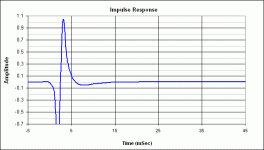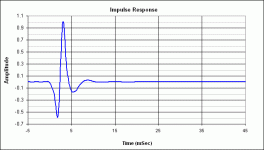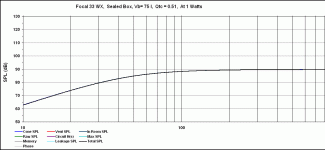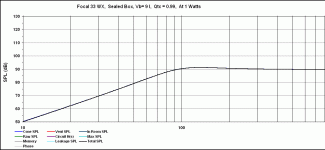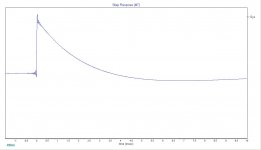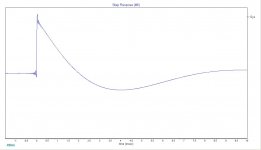Is there any direct relation between those 2 apart from the fact that both affect FR ? I know the optimal speaker Q factor is 0.5, which is critically damped for the best transient response. I also know that crossover Q affects speaker Q. So it's logical that EQ also affects speaker Q when low frequencies are EQd. But my question is, what part of the Q effect is affected, is it only FR or the ringing (transient response) too and if yes why, because at first sight one would think only the FR would be affected.
This has implications on the quality of bass, meaning that with EQing it would be impossible to get an accurate (transient perfect) bass without ringing if one uses EQ to raise bass response to desired level and speaker box Q is already 0.5 or higher.
Am I talking nonsense ? ...🙄
This has implications on the quality of bass, meaning that with EQing it would be impossible to get an accurate (transient perfect) bass without ringing if one uses EQ to raise bass response to desired level and speaker box Q is already 0.5 or higher.
Am I talking nonsense ? ...🙄
I know the optimal speaker Q factor is 0.5, which is critically damped for the best transient response.
You don't know that at all. You have read it somewhere and you
think you have figured it out. You see, when you say a speaker
unit in the box has Qtc of 0,5 that doesn't tell you much about the
sound. Without the Fc it could be any practical driver, an 18" PA woofer
or a 4" hifi woofer wanna be. I am not going to introduce a room
factor in the equation.
So, whenever you wish to boost the response around resonant
frequency you are effectively increasing its Q for Q is nothing but FR.
Each figure has its own specific curve. What should matter is how does
that sound to you in your specific application.
"Q is nothing but FR"
You're probably right but that contradicts what I've always read here and there about the effect of Q in ringing and transient response. If Q is nothing but FR it would affect only SPL at at given frequency, not ringing. Unless the ringing would be caused by the EQ and then we enter the difference between EQ Q and speaker box Q again...😱
You're probably right but that contradicts what I've always read here and there about the effect of Q in ringing and transient response. If Q is nothing but FR it would affect only SPL at at given frequency, not ringing. Unless the ringing would be caused by the EQ and then we enter the difference between EQ Q and speaker box Q again...😱
Hi JdAo,
There is a direct mathematical relationship between the time domain (Transient response) and the frequency domain (Frequency response) via the Discrete Fourier Transform or its faster computing algorithm, the Fast Fourier Transform or FFT.
The inverse is also true such that if you have the FR (magnitude and phase), you can apply the Inverse Fast Fourier Transform or IFFT to obtain the impulse response in the time domain. The Q of a system can easily be computed from the graphs of either the time domain or frequency domain responses.
Finally, if you were to measure the low frequency response of a loudspeaker that has a Qtc=0.7 (for example) and then apply EQ to force the response to match your target response of say 0.5, the resulting response would have the same time and frequency domain response as your target.
I would suggest you check out Linkwitz Lab - Loudspeaker Design for the linkwitz transform and do some research into parametric EQ circuits.
Hope this helps.
Peter
BTW, the room will play havoc with transient and frequency responses at low frequencies!
There is a direct mathematical relationship between the time domain (Transient response) and the frequency domain (Frequency response) via the Discrete Fourier Transform or its faster computing algorithm, the Fast Fourier Transform or FFT.
The inverse is also true such that if you have the FR (magnitude and phase), you can apply the Inverse Fast Fourier Transform or IFFT to obtain the impulse response in the time domain. The Q of a system can easily be computed from the graphs of either the time domain or frequency domain responses.
Finally, if you were to measure the low frequency response of a loudspeaker that has a Qtc=0.7 (for example) and then apply EQ to force the response to match your target response of say 0.5, the resulting response would have the same time and frequency domain response as your target.
I would suggest you check out Linkwitz Lab - Loudspeaker Design for the linkwitz transform and do some research into parametric EQ circuits.
Hope this helps.
Peter
BTW, the room will play havoc with transient and frequency responses at low frequencies!
JdAo,
The fact that you have read here or somewhere else these
conclusions does not guarantee its validity. People make mistakes,
including me.
We know for a fact that loudspeaker's measured behaviour can be
presented in the frequency domain using an appropriate algorithm
for an easier interpretation. The shape of the time domain curve
depends on the signal it represents. If it doesn't contain higher
frequencies, the first peak appears to be dulled or if there is not
much low frequencies, then the impulse appears to be shorter.
Lower frequencies have greater time period and this shows in time
domain. I have included simulation graphs so you can see how a
different box volume(tuning) changes both the time and frequency data.
Ringing appears to be an issue when the FR becomes so exaggerated
that it sounds boomy.
The fact that you have read here or somewhere else these
conclusions does not guarantee its validity. People make mistakes,
including me.
We know for a fact that loudspeaker's measured behaviour can be
presented in the frequency domain using an appropriate algorithm
for an easier interpretation. The shape of the time domain curve
depends on the signal it represents. If it doesn't contain higher
frequencies, the first peak appears to be dulled or if there is not
much low frequencies, then the impulse appears to be shorter.
Lower frequencies have greater time period and this shows in time
domain. I have included simulation graphs so you can see how a
different box volume(tuning) changes both the time and frequency data.
Ringing appears to be an issue when the FR becomes so exaggerated
that it sounds boomy.
Attachments
Last edited:
That seems to be exactly what I wanted to know. Thanks! I now have some digesting to do regarding the FFT stuff, will do that...
You might want to read this old article I wrote about transient response and Q. Particularly the addendum and the second page. Q=0.5 means critically damped. It does not me best transient response. And as for transient response, to what signal? Also remember there is a big difference between what happens for a forced response, while the signal is applied, and what happens when you look at the natural response. That is, when a system is disturbed, say by an impulse, and then allowed to return to rest in the absence of an applied signal. So, for example, you can look at two definitions (or more) of transient response: the ability of the system to follow an applied signal over a finite period of time, or how fast does the system returns to rest once the signal is removed. Which do you think is closer to music? What do you think Q of a plucked bass note is? How does the Q of the woofer effect the reproduction of such a note?
Box-Q
Box-Q
- Status
- Not open for further replies.
- Home
- Loudspeakers
- Multi-Way
- Speaker Q factor vs Analog EQ Q factor...doubt
